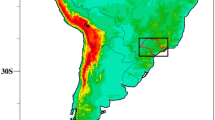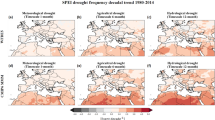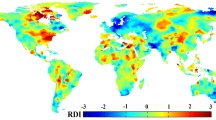Abstract
This study provides an evaluation of the past, present, and future spatiotemporal variability of droughts in the Bundelkhand region of central India. The assessment has been made by analyzing the existing (1951–2018) drought dynamics with gridded observational and reanalysis datasets. The future projection is presented using a multi-model ensemble from 21 simulations of regional climate model over CORDEX South-Asia domain under the highest carbon concentration, i.e., RCP8.5 emission scenario. The Standardized Precipitation Index (SPI) and the Standardized Precipitation Evapotranspiration Index (SPEI) indices are used for short and long-term monitoring of droughts. Spatiotemporal statistical analysis is performed to examine the relationship between drought indices, i.e., SPI, SPEI and driving parameters such as temperature, precipitation, etc. It is noticed that the frequency of drought has increased since the beginning of the 21st century. In particular, the northern part of the Bundelkhand region is more vulnerable to drought due to overall less precipitation and more temperature. The composite analysis of drought year indicates that moisture-laden wind from the Arabian Sea branch generally weakened in monsoon season. Teleconnections of drought over Bundelkhand region reveal that nearly 40% of the droughts are linked to El-Nino events that have become stronger in recent decades. The model ensemble realistically represents the regional climate reasonably well over the region. The projected change in near future drought shows more frequent events using both SPI and SPEI indices that are also detected in the observational analysis.
Research Highlights
-
The Northern region of Bundelkhand is more prone to drought due to high temperature and low precipitation.
-
The region receives most of its precipitation from Arabian Sea branch of monsoon winds that generally weakened in drought composite years.
-
About 40% of drought variability is teleconnected with El–Nino years that has become more stronger in recent decades
-
The ensemble of RCM simulations over CORDEX South–Asian domain indicates that the drought events are projected to be more frequent in near future.















Similar content being viewed by others
References
Abramowitz M and Irene S 1965 Handbook of mathematical functions with formulas, graphs and mathematical tables; National Bureau of Standards Applied Mathematics, Series No. 55.
Ahmed A, Deb D and Mondal S 2019 Assessment of rainfall variability and its impact on groundnut yield in Bundelkhand region of India; Curr. Sci. 117(5) 794–803.
Alam N M, Mishra P K, Jana C and Adhikary P P 2014 Stochastic model for drought forecasting for Bundelkhand region in Central India; Indian J. Agric. Sci. 84(2) 255–260.
Bhatla R, Verma S, Pandey R and Tripathi A 2019 Evolution of extreme rainfall events over Indo-Gangetic Plain in changing climate during 1901–2010; J. Earth Syst. Sci. 128(5) 1–14, https://doi.org/10.1007/s12040-019-1162-1.
Bhatla R, Verma S, Gupta A and Ghosh S 2020 Abrupt seasonal mean temperature variations over India during 1901–2010; J. Earth Syst. Sci. 129(1) 1–11, https://doi.org/10.1007/s12040-020-01421-0.
Bhatla R, Mohanty U C and Raju P V S 2006 The variability of Indian Ocean surface meteorological fields during summer monsoon in EL Nino/La Nina years; Indian J. Mar. Sci. 35(2) 93–103.
Chattopadhyay J and Bhatla R 1996 A reexamination ENSO/anti-ENSO events and simultaneous performance of the Indian summer monsoon; Mausam 47(1) 59–66.
Chattopadhyay J and Bhatla R 2002 Possible influence of QBO on teleconnections relating Indian summer monsoon rainfall and sea-surface temperature anomalies across the equatorial Pacific; Int. J. Climatol. 22(1) 121–127.
Dai A 2011 Drought under global warming: A review; Wiley Interdisciplinary Reviews: Climate Change 2(1) 45–65, https://doi.org/10.1002/wcc.81.
Deo K, Tripathi P, Kumar A, Singh K, Mishra S, Mishra A and Singh A 2015 rend of rainfall in different sectors of Uttar Pradesh under present scenario of climate change; Int. J. Environ. Sci. 6 303–310.
Gautam R C and Bana R S 2014 Drought in India: Its impact and mitigation strategies – A review; Indian J. Agronomy 59(2) 179–190.
Giorgi F, Coppola E, Mariotti L and Sylla M B 2012 RegCM4: Model description and preliminary tests over multiple CORDEX domains, https://doi.org/10.3354/cr01018.
Gupta A K and Singh A 2011 Traditional intellect in disaster risk mitigation: Indian Outlook – Rajasthan and Bundelkhand Icons; Indian J. Tradition. Knowl. 10(1) 156–166.
Gupta A K, Tyagi P and Sehgal V K 2011 Drought disaster challenges and mitigation in India: Strategic appraisal; Curr. Sci. 100(12) 1795–1806.
Gupta A, Nair S S, Ghosh O, Singh A and Dey S 2014 Bundelkhand drought: Retrospective analysis and way ahead; National Institute of Disaster Management, New Delhi, pp. 1–148.
Hargreaves G H, Zohrab A and Samani Z A 1985 Reference crop evapotranspiration from temperature; Appl. Eng. Agric. 1 96–99, https://doi.org/10.13031/2013.26773.
Jacob D and Podzun R 1997 Sensitivity studies with the regional climate model REMO; Meteorol. Atmos. Phys. 129 119–129.
Kalnay E, Kanamitsu M and Kistler R et al. 1996 The NCEP/NCAR 40-year reanalysis project; Bull. Am. Meteorol. Soc. 77 437–471, https://doi.org/10.1175/1520-0477(1996)077%3c0437:TNYRP%3e2.0.CO;2.
Kumar P, Wiltshire A and Mathison et al. 2013 Downscaled climate change projections with uncertainty assessment over India using a high resolution multi-model approach; Sci. Total. Environ. 468–469 S18–S30, https://doi.org/10.1016/j.scitotenv.2013.01.051.
Mcgregor J L 2005 C-CAM: Geometric aspects and dynamical formulation, CSIRO; Atmospheric Research Technical Paper 70.
Mckee T B, Doesken N J and Kleist J 1993 The relationship of drought frequency and duration to time scales; In: Eighth Conference on Applied Climatology.
Mishra A K and Singh V P 2010 A review of drought concepts; J. Hydrol. 391(1–2) 202–216, https://doi.org/10.1016/j.jhydrol.2010.07.012.
Nair S S and Singh A 2013 Drought risk and vulnerability analysis for Bundelkhand region of India; Research Gate 4(3) 1–19.
Parthasarathy B, Sontakke N A, Monot A A and Kothawale D R 1987 Droughts/floods in the summer monsoon season over different meteorological subdivisions of India for the period 1871–1984; J. Climatol. 7 57–70, https://doi.org/10.1002/joc.3370070106.
Pattanaik D R, Kumar G, Bhatla R and Soni V K et al. 2013 Heat index outlooks over the Indian region using general circulation model outputs; Vayumandal 39(1–2) 12–24.
Prajapati R K, Singh V K and Upadhayay A K 2018 Future of crop diseases and climate change in Bundelkhand Agro-climatic Zone of Madhya Pradesh: A review; Ann. Plant Soil Res. 20(1) 86–98.
Rajeevan M, Bhate J, Kale J D and Lal B 2006 A high resolution daily gridded rainfall data for the Indian Region: Analysis of break and active monsoon spells; Curr. Sci. 91(3) 296–306.
Rummukainen M, Ullerstig A, Hansson U, Graham P and Willen U 1998 RCA – Rossby Centre regional Atmospheric climate model; SMHI No. 83.
Shrestha A, Rahaman M M, Kalra A, Thakur B, Lamb K W and Maheshwari P 2020 Regional climatological drought: An assessment using high-resolution data; Hydrology 7 33, https://doi.org/10.3390/HYDROLOGY7020033.
Srivastava A K, Rajeevan M and Kshirsagar S R 2009 Development of a high resolution daily gridded temperature data set (1969–2005) for the Indian region; Atmos. Sci. Lett. 10(4) 249–254, https://doi.org/10.1002/asl.
Thomas T, Jaiswal R K, Galkate R, Nayak P C and Ghosh N C 2016a Drought indicators-based integrated assessment of drought vulnerability: A case study of Bundelkhand droughts in central India; Nat. Hazards 81(3) 1627–1652, https://doi.org/10.1007/s11069-016-2149-8.
Thomas T, Jaiswal R K, Galkate R V and Nayak T R 2016b Reconnaissance drought index based evaluation of meteorological drought characteristics in Bundelkhand; Procedia Technology 24 23–30, https://doi.org/10.1016/j.protcy.2016.05.005.
Thomas T, Nayak P C and Ghosh N C 2015 Spatiotemporal analysis of drought characteristics in the Bundelkhand region of central India using the standardized precipitation index; J. Eng. Hydrol., https://doi.org/10.1061/(ASCE)HE.1943-5584.0001189.
Titchner H A and Rayner N A 2014 The Met Office Hadley Centre sea ice and sea surface temperature data set, version 2: 1. Sea ice concentrations; J. Geophys. Res. Atmos. 119 2864–2889, https://doi.org/10.1002/2013JD020316.
Vicente-Serrano S M, Beguería S and López-Moreno J I et al. 2010 A multiscalar drought index sensitive to global warming: The standardized precipitation evapotranspiration index; J. Clim. 23 1696–1718, https://doi.org/10.1175/2009JCLI2909.1.
Acknowledgements
MSS acknowledges the fellowship from Dept. of Science and Technology (DST), Govt. of India INSPIRE Fellowship no. IF160281. PK acknowledges funding from the Science and Engineering Research Board (SERB), Govt. of India grant number SB/S2/RJN-080/2014 and DST, Govt. of India grant number DST/CCP/NCM/69/2017. Authors are thankful to the India Meteorological Department and Regional modelling group for providing the observational and model datasets, respectively.
Author information
Authors and Affiliations
Contributions
PK convinced the idea. All the authors contributed to the designing of the manuscript. ASM and MSS prepared the figures with help from PK. All authors contributed to the writing of the manuscript and its result interpretations.
Corresponding author
Additional information
Communicated by Kavirajan Rajendran
Appendices
A. Appendix
A.1 SPI Calculation
SPI is derived by fitting gamma distribution function. It is then transformed into standard normal distribution where the mean value is zero and variance is one (McKee et al. 1993).
The gamma distribution is defined by probability density function (p.d.f.) as
where α > 0, α is a shape parameter; β > 0, β is a scale parameter; x > 0, x is the precipitation amount.
The cumulative probability distribution function G(x) is obtained from integrating p.d.f. as:
where
n is the number of precipitation observations.
Let t = x/\(\hat{\beta }\), putting it in G(x)
For x = 0, the gamma function is undefined therefore the cumulative probability becomes
Here q is the value when the probability at x = 0.
To get SPI value, the cumulative probability function has to be converted into a standard normal cumulative distribution function having mean value zero and variance as one. Then SPI is calculated using Abramowitz and Stegun (1965) approximation as:
where
\(C_{0} = 2.515517\), \(C_{1} = 0.802853\), \(C_{2} = 0.010328\), \(d_{1} = 1.432788\), \(d_{2} = 1.89269\) and \(d_{3} = 0.001308\).
A.2 SPEI calculation
The SPEI is calculated as
where \({D}_{i}\) is aggregate at different time scale, Pi is monthly precipitation and PET is the monthly potential evapotranspiration.
The probability density function (for log logistic distributed variable) is given by
where α is a scale parameter for D values
β is a shape parameter for D values
\(\gamma \) is an origin parameter for D values
\(\gamma = W_{0} - \alpha {\varGamma }\left( {1 + \frac{1}{\beta }} \right){\varGamma }\left( {1 - \frac{1}{\beta }} \right)\).
Probability weighted moments (PWMs) calculated by
where S is an order of PWMs, N is the number of data, Fi is the frequency estimator and can be expressed as:
where i is a range of observations.
The unbiased PWMs calculated as:
Therefore now p.d.f. is given by according to log logistic distribution for D is given as:
The standard value of F(x) is SPEI. Therefore,
where
Constants hold the same value as in SPI for \( C_{0} , C_{1} , C_{2} \) and \(d_{1} , d_{2} , d_{3}\) mentioned above in SPI calculation section.
Rights and permissions
About this article
Cite this article
Saharwardi, M.S., Mahadeo, A.S. & Kumar, P. Understanding drought dynamics and variability over Bundelkhand region. J Earth Syst Sci 130, 122 (2021). https://doi.org/10.1007/s12040-021-01616-z
Received:
Revised:
Accepted:
Published:
DOI: https://doi.org/10.1007/s12040-021-01616-z




